Three in five of the population 15 years old and over are in the labor force
The population 15 years old and over in January 2014 was estimated at 61.8 million wherein around 39.4 million persons were reported to be in the labor force, that is, either employed or unemployed (Table 1 and Table 3). These figures placed the labor force participation rate (LFPR) at 63.8 percent. In January 2013, the LFPR was estimated at 64.1 percent. Among the regions, Autonomous Region in Muslim Mindanao (ARMM) registered the lowest LFPR at 57.3 percent (Figure 1).
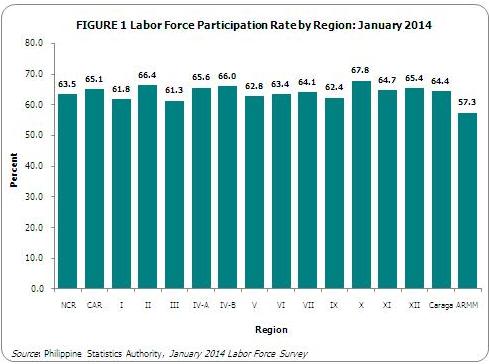
Employment rate is recorded at 92.5 percent
The employment rate or the proportion of employed persons to total labor force was estimated at 92.5 percent in January 2014 (Table 1). This placed the number of employed persons at about 36.4 million (Table 2). Last year’s employment rate was 92.9 percent.
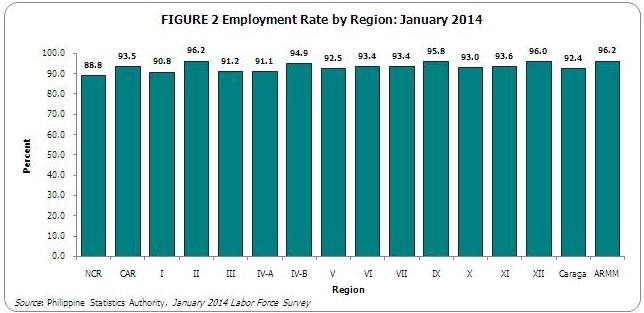
Across regions, the top three regions in terms of employment rate are Cagayan Valley and ARMM with 96.2 percent, respectively, and SOCCSKSARGEN (96.0%) (Table 1 and Figure 2).
Three in five of the employed persons are males
In January 2014, three in every ten (26.7%) of the total employed were in the age group 25 to 34. Those in the age group 35 to 44 made up 23.1 percent, while the 15 to 24 age group, 18.8 percent (Table 3).
Three in five (60.5%) of the employed persons in January 2014 were males.
More than half of the employed population are working in the services sector
Workers in the services sector comprised more than one-half (54.1%) of the total employed population in January 2014. Three in every ten (30.1%) were in the agriculture sector and 15.9 percent were in the industry sector (Table 4 and Figure 4).
Classified according to subsector of major industry groups, workers in agriculture, hunting and forestry sub-sector comprised the biggest percentage (26.6%) of the total employed. Those in the wholesale and retail trade; repair of motor vehicles and motorcycles came next registering 18.7 percent of the total employed (Table 4).
Three in ten of the total employed population are laborers and unskilled workers
Among the various occupation groups, laborers and unskilled workers made up the largest occupation group, accounting for 31.3 percent of the employed population. Officials of government and special interest organizations, corporate executives, managers, managing proprietors and supervisors were the second largest group, accounting for 16.5 percent of the total employed population (Table 5 and Figure 5).
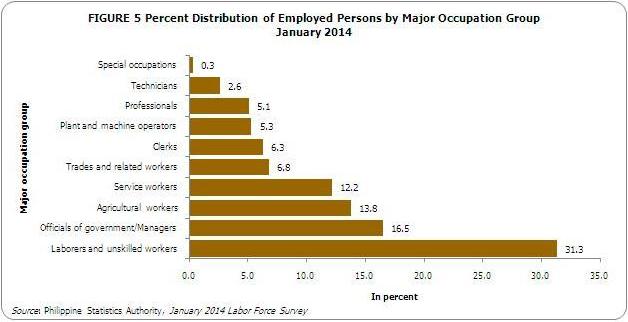
More than half of the employed persons are wage and salary workers
Employed persons fall into any of these categories: wage and salary workers, self-employed without any paid employee, employer in own family-operated farm or business and unpaid family workers. Wage and salary workers are those who work for private households, private establishments, government and government-controlled corporations and those who work with pay in own family-operated farm or business. More than half (57.5%) of the total employed persons in January 2014 were wage and salary workers, most of them (44.1% of the total employed) worked for private establishments. Those working for the government and government-controlled corporations accounted for 7.9 percent of the total employed. The unpaid family workers made up 10.6 percent (Table 6).
More than two-thirds (67.7%) of the unpaid family workers were in the agriculture sector. In contrast, the majority of the wage and salary workers were in the services sector with more than three-fifths (61.6%) of such workers belonging to that sector (Table 7 and Figure 6).
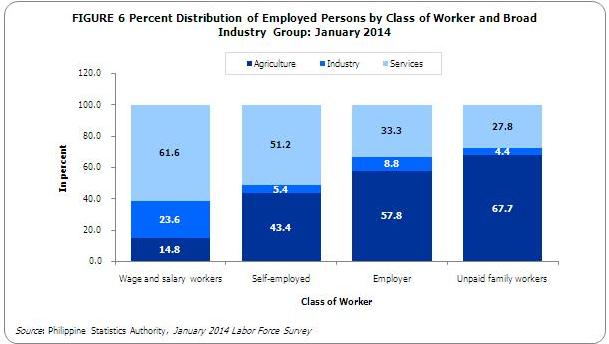
Three in five of the employed persons are full-time workers
Employed persons are classified as either full-time workers or part-time workers. Full-time workers are those who work for 40 hours or more while part-time workers work for less than 40 hours. In January 2014, three in every five (62.2%) of the total employed persons were working full time. Two in five (40.2%) of the total employed worked for 40 to 48 hours. Around 36.0 percent of the total employed persons were working part time (Table 8).
One-fifth of the employed persons desires more hours of work
Employed persons who express the desire to have additional hours of work in their present job or to have an additional job, or to have a new job with longer working hours are considered underemployed. The underemployment rate or the proportion of underemployed to the total employed persons is estimated at 19.5 percent in January 2014. About three-fifths (58.9%) of the total underemployed were reported as visibly underemployed or working less than 40 hours during the reference week. Those working for 40 hours or more accounted for 38.7 percent of the total underemployed (Table 9).
Of the total underemployed, those working in the services sector made up 41.1 percent, while those in the agriculture sector, 41.7 percent. The underemployed in the industry sector accounted for 17.2 percent of the total underemployed (Figure 7). Of the underemployed workers in the services sector, 47.8 percent were part-time workers. By comparison, 40.4 percent of the underemployed in the industry sector were working part-time. As to be expected, the corresponding percentage in the agriculture sector was high at 77.5 percent (Table 9).
Unemployment rate is recorded at 7.5 percent
In January 2014, the unemployment rate or the proportion of unemployed persons to the labor force was estimated at 7.5 percent (Table 1). This placed the number of unemployed persons at around 3.0 million (Table 2). In the same month last year, the estimate was 7.1 percent. The unemployment rate in the National Capital Region (11.2%), Ilocos Region (9.2%) and CALABARZON (8.9%) was higher than in the other regions (Table 1 and Figure 8).
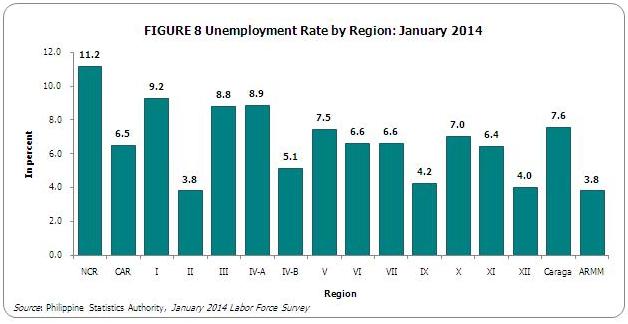
Three-fifths (63.9%) of the unemployed were males. About one-half (48.2%) of the unemployed were in age group 15 to 24 years (Table 3).
Across educational groups, 34.0 percent of the total unemployed were high school graduates, 6.7 percent were post secondary graduates, 13.3 percent were college undergraduates, and 19.8 percent were college graduates (Table 10).
Seven in ten of the persons who are not in the labor force are women
In January 2014, 36.2 percent of the population 15 years old and over were not in the labor force, like housewives, students, persons with disability, and retirees. Seven in ten (69.6%) of those who were not in the labor force were females.
Forty-five percent of those who were not in the labor force belonged to the age group 15 to 24 years (Table 3).
SUMMARY
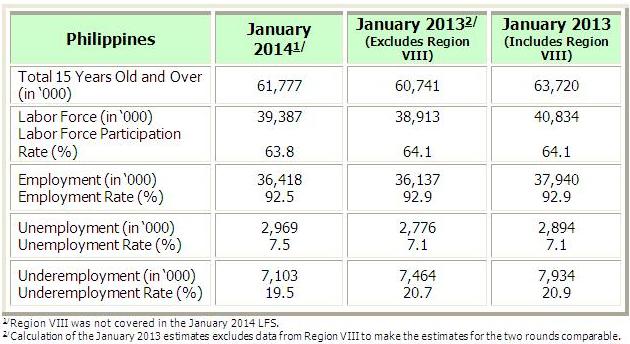
 Out of the estimated 61.8 million population 15 years old and over, there were 39.4 million persons in the labor force.
Out of the estimated 61.8 million population 15 years old and over, there were 39.4 million persons in the labor force.
 The employment rate in January 2014 registered at 92.5 percent. The employment rate for the same month of 2013, computed using data from January 2013 that excludes Region VIII, is 92.9 percent.
The employment rate in January 2014 registered at 92.5 percent. The employment rate for the same month of 2013, computed using data from January 2013 that excludes Region VIII, is 92.9 percent.
 More than half (54.1%) of the employed population were in the services sector, 30.1 percent were in the agriculture sector and the rest (15.9%) were in the industry sector.
More than half (54.1%) of the employed population were in the services sector, 30.1 percent were in the agriculture sector and the rest (15.9%) were in the industry sector.
 Laborers and unskilled workers remained to be the largest occupation group as they comprised almost one-third (31.3%) of the employed population. Officials of government and special interest organizations, corporate executives, managers, managing proprietors and supervisors came next with 16.5 percent.
Laborers and unskilled workers remained to be the largest occupation group as they comprised almost one-third (31.3%) of the employed population. Officials of government and special interest organizations, corporate executives, managers, managing proprietors and supervisors came next with 16.5 percent.
 More than half (57.5%) of the total employed persons were wage and salary workers, 28.5 percent were self-employed, 3.4 percent were employers in own family-operated farm or business, and 10.6 percent were unpaid family workers.
More than half (57.5%) of the total employed persons were wage and salary workers, 28.5 percent were self-employed, 3.4 percent were employers in own family-operated farm or business, and 10.6 percent were unpaid family workers.
 Underemployment rate was estimated at 19.5 percent in January 2014. Last year’s rate was 20.9 percent.
Underemployment rate was estimated at 19.5 percent in January 2014. Last year’s rate was 20.9 percent.
 Unemployment rate in January 2014 was estimated at 7.5 percent. In the same month last year, the unemployment rate was 7.1 percent.
Unemployment rate in January 2014 was estimated at 7.5 percent. In the same month last year, the unemployment rate was 7.1 percent.
Technical Notes
The Labor Force Survey (LFS) is a nationwide survey conducted quarterly by the Philippine Statistics Authority-National Statistics Office (PSA-NSO). For this release, the data being presented are based on the final results of the January 2014 round of the LFS.
The reference period used in the survey is the seven (7) days preceding the date of visit of the enumerator. The number of sample households was about 50,000.
The concepts and definitions used in the survey can be found in NSO-ISH Bulletins. Some are given below:
a. Labor Force – refers to the population 15 years old and over who contribute to the production of goods and services in the country. It comprises the employed and unemployed.
b. Employed – refers to persons in the labor force who are reported either as at work or with a job or business although not at work. Persons at work are those who did some work, even for an hour during the reference period.
c. Unemployed – refers to persons in the labor force who are reported as:
1) without work; and
2) currently available for work; and
3) seeking work or not seeking work due to the following reasons:
i) belief that no work is available, or
ii) awaiting results of previous job application, or
iii) because of temporary illness or disability, or
iv) bad weather, or
v) waiting for rehire or job recall.
The new definition of unemployed was adopted starting April 2005 per NSCB Resolution No. 15 dated October 20, 2004.
The old definition of unemployed considered only two criteria:
1) Without work and looking for work; or
2) Without work and not looking for work due to reasons cited in 3(i) to 3(v).
d. Underemployed – refers to employed persons who express the desire to have additional hours of work in their present job or an additional job, or have a new job with longer working hours.
e. Labor Force Participation Rate (LFPR) – proportion of total labor force to the total household population 15 years and over.
f. Employment Rate – proportion of employed persons to the total labor force.
g. Unemployment Rate – proportion of unemployed persons to the total labor force.
h. Underemployment Rate – proportion of underemployed persons to total employed persons.
Starting with the July 2003 round, the LFS used the 2003 Master Sample Design. Using this design, the number of sample households is around 50,000 households.
The province of Basilan is included in the Autonomous Region in Muslim Mindanao while Isabela City (Basilan) is placed under Region IX, in accordance with Executive Order No. 36.
Starting with the July 2007 LFS round, the population projections based on the 2000 Census of Population and Housing (CPH) was adopted to generate the labor force statistics. The 2000 CPH- based population projections has been endorsed as the official figures to be utilized for planning and programming purposes per NSCB Resolution No. 7 Series of 2006, entitled “Adopting the Methodology Used in Generating the 2000 Census of Population and Housing-Based National Regional and Provincial Population Projections”.
In the LFS, data on the economic characteristics of household members who are overseas workers are not collected because they are not considered as part of the labor force in the country. Hence, they are excluded in the estimation of the size of working population, that is, population aged 15 years and older.
Starting with the January 2010 LFS round, a revised nomenclature on class of worker is adopted. In the reports on previous rounds of LFS, particularly in the statistical tables on employed persons by class of worker, the self-employed and employer in own family-operated farm or business were classified as own-account workers. For the same statistical table in this report, the term own-account worker no longer appears as heading for employer and self-employed to avoid confusion. In the International Classification of Status in Employment (ICSE), the term “own-account worker” is synonymous to the category “self-employed” in the Philippines LFS.
Starting January 2012 LFS, the codes for industry adopted the 2009 Philippine Standard Industrial Classification (PSIC). Prior to this, codes for industry used the 1994 PSIC. While in the classification of occupation, the 1992 four-digit code for Philippine Standard Occupational Classification updated in 2002 (PSOC) was still utilized.
Region VIII was not covered in the January 2014 LFS, to comply with the master sample design currently being used, which defines the regions as domains. With the regions as domains, the precision of the regional estimates of the employment indicators is assured.



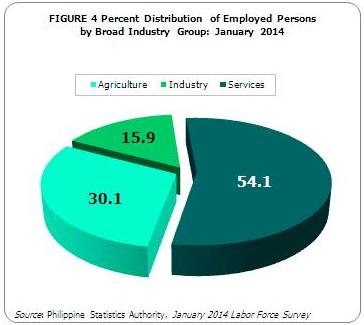


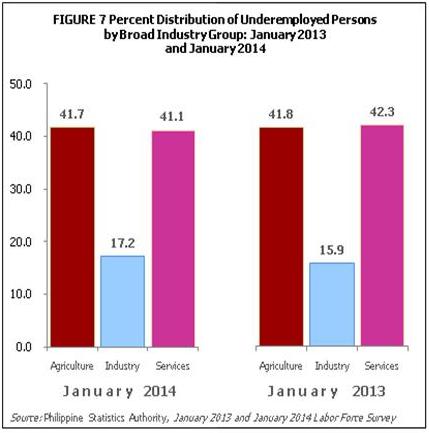

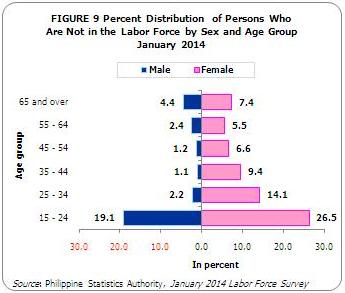

![]() Out of the estimated 61.8 million population 15 years old and over, there were 39.4 million persons in the labor force.
Out of the estimated 61.8 million population 15 years old and over, there were 39.4 million persons in the labor force.![]() The employment rate in January 2014 registered at 92.5 percent. The employment rate for the same month of 2013, computed using data from January 2013 that excludes Region VIII, is 92.9 percent.
The employment rate in January 2014 registered at 92.5 percent. The employment rate for the same month of 2013, computed using data from January 2013 that excludes Region VIII, is 92.9 percent.![]() More than half (54.1%) of the employed population were in the services sector, 30.1 percent were in the agriculture sector and the rest (15.9%) were in the industry sector.
More than half (54.1%) of the employed population were in the services sector, 30.1 percent were in the agriculture sector and the rest (15.9%) were in the industry sector.![]() Laborers and unskilled workers remained to be the largest occupation group as they comprised almost one-third (31.3%) of the employed population. Officials of government and special interest organizations, corporate executives, managers, managing proprietors and supervisors came next with 16.5 percent.
Laborers and unskilled workers remained to be the largest occupation group as they comprised almost one-third (31.3%) of the employed population. Officials of government and special interest organizations, corporate executives, managers, managing proprietors and supervisors came next with 16.5 percent.![]() More than half (57.5%) of the total employed persons were wage and salary workers, 28.5 percent were self-employed, 3.4 percent were employers in own family-operated farm or business, and 10.6 percent were unpaid family workers.
More than half (57.5%) of the total employed persons were wage and salary workers, 28.5 percent were self-employed, 3.4 percent were employers in own family-operated farm or business, and 10.6 percent were unpaid family workers.![]() Underemployment rate was estimated at 19.5 percent in January 2014. Last year’s rate was 20.9 percent.
Underemployment rate was estimated at 19.5 percent in January 2014. Last year’s rate was 20.9 percent.![]() Unemployment rate in January 2014 was estimated at 7.5 percent. In the same month last year, the unemployment rate was 7.1 percent.
Unemployment rate in January 2014 was estimated at 7.5 percent. In the same month last year, the unemployment rate was 7.1 percent.